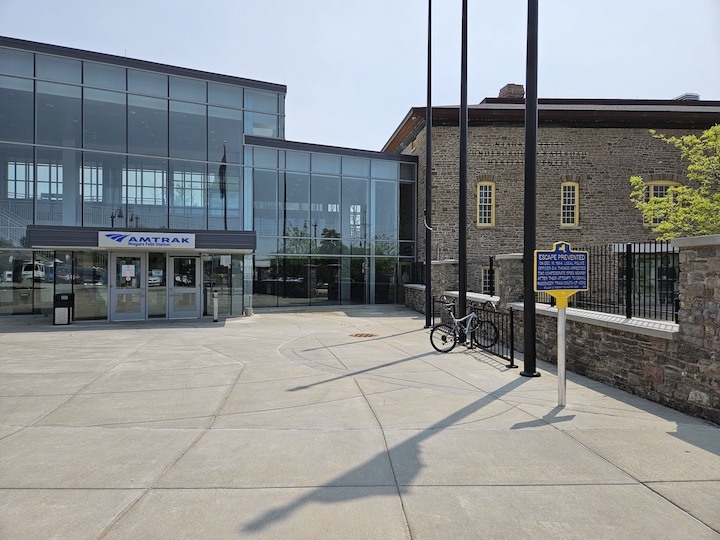Featured News - Current News - Archived News - News Categories
The Niagara Frontier Chapter of the National Railway Historical Society joined City of Niagara Falls Mayor Robert Restaino, Niagara Falls National Heritage Area Executive Director Sara Capen, and Niagara Falls Underground Railroad Heritage Center Director of Community Engagement Saladin Allah for a dedication ceremony Saturday, in observance of a new historical marker at the intersection of Depot Avenue West and Whirlpool Street.
Located outside of the Amtrak station and Niagara Falls Underground Railroad Heritage Center, the sign reads, “On Dec. 16, 1864, local police officer D.H. Thomas arrested two Confederate spies nearby after their attempt to derail passenger train south of here.” It was erected by the William G. Pomeroy Foundation and the National Railway Historical Society Niagara Frontier Chapter.
Project Manager Anton Schwarzmueller said, “Thank you all for coming here today to dedicate this historical marker in honor of a forgotten local policeman and his act of arresting a pair of Confederate spies in the later throes of the Civil War. Who were these two spies? George S. Anderson, age 17, who testified against the other, Capt. John Yates Bell.”
He explained, “Beall and others, led by Col. William T. Martin, conspired to rob a train between Buffalo and Dunkirk. Seventeen-year-old Confederate Anderson rode a train with the colonel and a Lt. Hadley to Dunkirk, the plan being to ‘capture’ a train on the way back to Buffalo, but this was not done. They walked five or six miles south of Buffalo, Beall joining them along the way. They tried to pull a rail out of place with a sledge – possessed by Beall – and a chisel, but failed. They fled to Port Colborne in Canada, stayed a day, and returned with a fifth man for another try. They procured a sleigh, went five miles south, but they missed the train. They stayed overnight at a hotel and tried again at 2 o’clock on Dec. 16, 1864, placing a rail across the tracks. This failed to derail the train.”
Schwarzmueller said, “Trains of 1864 were very different from the trains of today. Passenger coaches were mostly of wood and heated by wood stoves. Derailing a passenger train could have horrific results, with coaches smashing apart and catching fire from the stoves. These Confederate saboteurs had no qualms about causing death and injury to innocent civilians. In the language of today, we call them terrorists. It reflected the desperation of the Confederacy to convince the Union populace to end the war before winning it.
“Now Beall and Anderson were in the New York Central passenger depot on Depot Avenue between 9th and 10th Streets at 9 or 10 o’clock at night on Dec. 16, 1864, waiting for the 11 o’clock train to Canada. Officer David H. Thomas of the Village of Niagara City (aka: Suspension Bridge) and his partner, by the name of Saules, approached Beall and Anderson. Officer Thomas questioned Beall. Initially, Beall identified himself as John Beall, then claimed he was W.W. Baker, the name of one of his cohorts in the Chesapeake raids. Beall denied that; he said he was John Beall. Both Beall and Anderson were in civilian clothes, and Beall was in possession of a loaded Colt firearm.
“Officer Thomas arrested them, accusing Beall of being an escaped prisoner from Point Lookout, Chesapeake Bay. This was a Union prison in Maryland at the mouth of the Potomac River. To this, Beall admitted, though it was false, later stating that he had gone to Baltimore and from there to escape to Canada. He added that he had vowed not to be taken and would have shot Officer Thomas had the officer not come to him so suddenly or unexpectedly.”
Schwarzmueller added, “Policeman David H. Thomas, who’s name appears on the marker – who arrested the two Confederates, preventing their escape to Canada, preventing them from committing further acts of terrorism – was at his life’s end a station master of the Erie Railroad, residing near Division and Main streets here.”
His remains are buried in Oakwood Cemetery.
“And so today, we resurrect the name of a local hero from the dustbin of history,” Schwarzmueller said.
Read more at https://www.hmdb.org.

Images courtesy of Anton Schwarzmueller // https://www.hmdb.org





























